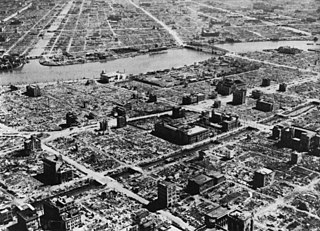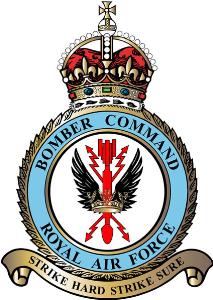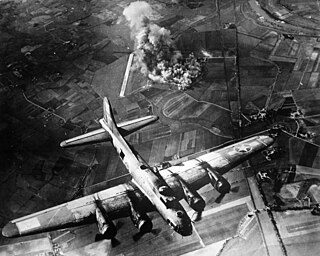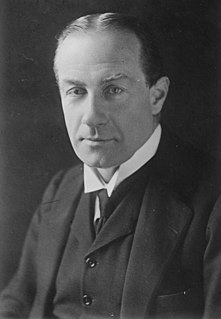
Strategic bombing is a military strategy used in total war with the goal of defeating the enemy by destroying its morale, its economic ability to produce and transport materiel to the theatres of military operations, or both. It is a systematically organized and executed attack from the air which can utilize strategic bombers, long- or medium-range missiles, or nuclear-armed fighter-bomber aircraft to attack targets deemed vital to the enemy's war-making capability.

The Battle of Britain, also known as the Air Battle for England, was a military campaign of the Second World War, in which the Royal Air Force (RAF) and the Fleet Air Arm (FAA) of the Royal Navy defended the United Kingdom (UK) against large-scale attacks by Nazi Germany's air force, the Luftwaffe. It has been described as the first major military campaign fought entirely by air forces. The British officially recognise the battle's duration as being from 10 July until 31 October 1940, which overlaps the period of large-scale night attacks known as the Blitz, that lasted from 7 September 1940 to 11 May 1941. German historians do not accept this subdivision and regard the battle as a single campaign lasting from July 1940 to May 1941, including the Blitz.

The bombing of Dresden was a British-American aerial bombing attack on the city of Dresden, the capital of the German state of Saxony, during World War II. In four raids between 13 and 15 February 1945, 722 heavy bombers of the British Royal Air Force (RAF) and 527 of the United States Army Air Forces (USAAF) dropped more than 3,900 tons of high-explosive bombs and incendiary devices on the city. The bombing and the resulting firestorm destroyed more than 1,600 acres (6.5 km2) of the city centre. An estimated 22,700 to 25,000 people were killed. Three more USAAF air raids followed, two occurring on 2 March aimed at the city's railway marshalling yard and one smaller raid on 17 April aimed at industrial areas.

The Blitz was a German bombing campaign against the United Kingdom in 1940 and 1941, during the Second World War. The term was first used by the British press and originated from the term Blitzkrieg, the German word for 'lightning war'.

Firebombing is a bombing technique designed to damage a target, generally an urban area, through the use of fire, caused by incendiary devices, rather than from the blast effect of large bombs.

The Baedeker Blitz or Baedeker raids were a series of attacks by the Luftwaffe on English cities during the Second World War. The name derives from Baedeker, a series of German tourist guidebooks, including detailed maps, which were used to generate targets for bombing.

RAF Bomber Command controlled the Royal Air Force's bomber forces from 1936 to 1968. Along with the United States Army Air Forces, it played the central role in the strategic bombing of Germany in World War II. From 1942 onward, the British bombing campaign against Germany became less restrictive and increasingly targeted industrial sites and the civilian manpower base essential for German war production. In total 364,514 operational sorties were flown, 1,030,500 tons of bombs were dropped and 8,325 aircraft lost in action. Bomber Command crews also suffered a high casualty rate: 55,573 were killed out of a total of 125,000 aircrew, a 44.4% death rate. A further 8,403 men were wounded in action, and 9,838 became prisoners of war.

Strategic bombing during World War II involved sustained aerial attacks on railways, harbours, cities, workers' and civilian housing, and industrial districts in enemy territory during World War II (1939–1945). Strategic bombing as a military strategy is distinct both from close air support of ground forces and from tactical air power. During World War II, many military strategists of air power believed that air forces could win major victories by attacking industrial and political infrastructure, rather than purely military targets. Strategic bombing often involved bombing areas inhabited by civilians, and some campaigns were deliberately designed to target civilian populations in order to terrorize them and disrupt their usual activities. International law at the outset of World War II did not specifically forbid the aerial bombardment of cities – despite the prior occurrence of such bombing during World War I (1914–1918), the Spanish Civil War (1936–1939), and the Second Sino-Japanese War (1937–1945).

The bombing of Warsaw in World War II started with the aerial bombing campaign of Warsaw by the German Luftwaffe during the siege of Warsaw in the invasion of Poland in 1939. It also included German bombing raids during the Warsaw Uprising in 1944. During the course of the war, approximately 85% of the city was destroyed due to German mass bombings, heavy artillery fire, and a planned demolition campaign.

Berlin, then the capital of Nazi Germany, was subject to 363 air raids during the Second World War. It was bombed by the RAF Bomber Command between 1940 and 1945, by the USAAF Eighth Air Force between 1943 and 1945, and the French Air Force between 1944 and 1945, as part of the Allied campaign of strategic bombing of Germany. It was also attacked by aircraft of the Red Air Force, in 1941 and particularly in 1945 as Soviet forces closed on the city. British bombers dropped 45,517 tons of bombs, while American aircraft dropped 23,000 tons. As the bombings continued, more and more people fled the city. By May 1945, 1.7 million people had fled.

The German city of Cologne was bombed in 262 separate air raids by the Allies during World War II, all by the Royal Air Force (RAF). A total of 34,711 long tons of bombs were dropped on the city by the RAF. 20,000 people died during the war in Cologne due to aerial bombardments.

During World War II, Braunschweig was attacked by Allied aircraft in 42 bombing raids. On the night of 14/15 October 1944, the attack by No. 5 Group Royal Air Force (RAF) marked the high point of the destruction of Henry the Lion's city during the war. The air raid was part of Operation Hurricane, which was designed to demonstrate the capabilities of the Allied bombing campaign. The attack caused a massive conflagration, that might have developed into a firestorm, and resulted in Braunschweig burning continuously for two and a half days from 15 to 17 October. More than 90 percent of the medieval city centre was destroyed, changing the city's appearance to the present day.

The Battle of Berlin was a series of attacks on Berlin by RAF Bomber Command along with raids on other German cities to keep German defences dispersed. Air Chief Marshal Sir Arthur Harris, AOC-in-C Bomber Command, believed that "We can wreck Berlin from end to end if the USAAF come in with us. It will cost us between 400 and 500 aircraft. It will cost Germany the war".

The Combined Bomber Offensive (CBO) was an Allied offensive of strategic bombing during World War II in Europe. The primary portion of the CBO was directed against Luftwaffe targets which was the highest priority from June 1943 to 1 April 1944. The subsequent highest priority campaigns were against V-weapon installations and petroleum, oil, and lubrication (POL) plants. Additional CBO targets included railyards and other transportation targets, particularly prior to the invasion of Normandy and, along with army equipment, in the final stages of the war in Europe.

During World War II, the German city of Heilbronn was bombed numerous times by the British Royal Air Force and the United States Army Air Forces. The largest air-raid occurred on December 4, 1944, but Heilbronn was targeted several times before and after until the end of World War II. Altogether, an estimated 7,000 inhabitants of the city lost their lives during bombings.

"The bomber will always get through" was a phrase used by Stanley Baldwin in a 1932 speech "A Fear for the Future" given to the British Parliament. His speech stated that contemporary bomber aircraft had the performance necessary to conduct a strategic bombing campaign that would destroy a country's cities and there was little that could be done in response. It concluded that the conduct of future wars would require one to "kill more women and children more quickly than the enemy if you want to save yourselves."

The Defence of the Reich is the name given to the strategic defensive aerial campaign fought by the Luftwaffe air arm of the combined Wehrmacht of Nazi Germany over German-occupied Europe and Nazi Germany during World War II. Its aim was to prevent the destruction of German civilians, military and civil industries by the Western Allies. The day and night air battles over Germany during the war involved thousands of aircraft, units and aerial engagements to counter the Allied strategic bombing campaign. The campaign was one of the longest in the history of aerial warfare and with the Battle of the Atlantic and the Allied Blockade of Germany was the longest of the war. The Luftwaffe fighter force defended the airspace of German-occupied territory against attack, first by RAF Bomber Command and then against the United States Army Air Forces (USAAF) in the Combined Bomber Offensive.

Air warfare was a major component in all theaters of World War II, and, together with anti-aircraft warfare, consumed a large fraction of the industrial output of the major powers. Germany and Japan depended on air forces that were closely integrated with land and naval forces; the Axis powers downplayed the advantage of fleets of strategic bombers, and were late in appreciating the need to defend against Allied strategic bombing. By contrast, Britain and the United States took an approach that greatly emphasised strategic bombing, and tactical control of the battlefield by air, as well as adequate air defences. Both Britain and the U.S. built substantially larger strategic forces of large, long-range bombers. Simultaneously, they built tactical air forces that could win air superiority over the battlefields, thereby giving vital assistance to ground troops. The U.S. and Royal Navy also built a powerful naval-air component based on aircraft carriers, as did the Japanese; these played the central role in the war at sea.

Operation Gisela was the codename for a German military operation of the Second World War. Gisela was designed as an aerial intruder operation to support the German air defence system in its night battles with RAF Bomber Command during the Defence of the Reich campaign. It was the last major operation launched by the LuftwaffeNachtjagdgeschwader during the conflict.


















